Want better marketing results? These big data tools can help you analyze customer behavior, track campaigns, and optimize strategies in real time. Here's a quick overview of the top tools marketers are using today:
- Apache Hadoop: Processes massive datasets for customer segmentation and campaign analysis.
- Apache Spark: Real-time insights and predictive analytics with 100x faster processing than Hadoop.
- Tableau: Turns complex data into clear, interactive visualizations for smarter decisions.
- Microsoft Power BI: Affordable, AI-powered analytics with seamless integration into the Microsoft ecosystem.
- Google BigQuery: Scalable, cloud-based data warehousing for real-time marketing insights.
- Supermetrics: Simplifies data integration from 60+ platforms for quick reporting.
- Adverity: AI-powered data unification and visualization for large-scale marketing teams.
- Funnel.io: Easy multi-channel data integration and real-time dashboards.
- SEMrush: Powerful SEO and marketing analytics for improving traffic and conversions.
- Marketing Analytics Tools Directory: Compare tools side-by-side to find the best fit for your needs.
Quick Comparison:
| Tool | Best For | Starting Price |
|---|---|---|
| Apache Hadoop | Massive data processing | Free (Open-source) |
| Apache Spark | Real-time analytics | Free (Open-source) |
| Tableau | Data visualization | $35/user/month |
| Microsoft Power BI | Business intelligence | $9.99/user/month |
| Google BigQuery | Cloud-based scalability | Usage-based pricing |
| Supermetrics | Multi-channel reporting | $39/month |
| Adverity | Large-scale marketing data | Custom pricing |
| Funnel.io | Automating data workflows | $499/month |
| SEMrush | SEO and traffic analysis | $119.95/month |
These tools make it easier to turn big data into actionable insights. Whether you need real-time analytics, predictive modeling, or seamless data integration, there's a tool for every marketing need. Let’s dive into how each platform works.
The Top 5 Best Big Data Analytics Tools & Solutions
1. Apache Hadoop
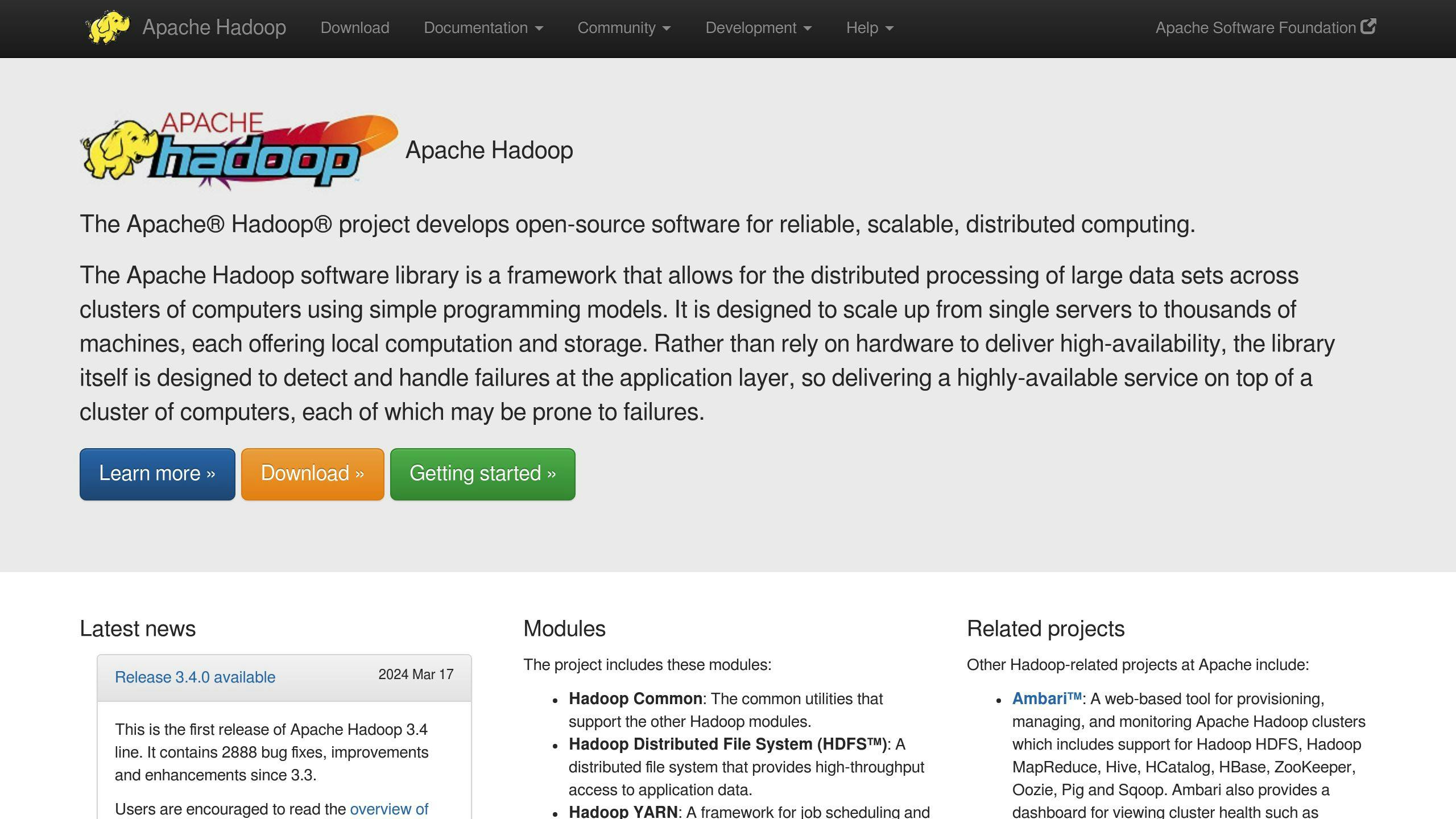
Apache Hadoop is an open-source framework built to handle massive datasets across distributed systems. By breaking data into smaller chunks for parallel processing, it speeds up analysis, making it a go-to tool for marketers dealing with large-scale data.
Its main strength for marketers is processing huge amounts of data efficiently, helping them uncover insights from complex datasets. Here are some common marketing applications:
- Customer Behavior Analysis: Analyze data from website visits, social media interactions, and purchase histories.
- Campaign Performance Tracking: Evaluate metrics across multiple marketing channels.
- Customer Segmentation: Use data from various sources to create detailed customer segments.
Doug Cutting, Co-Founder of Apache Hadoop, highlights its importance:
"Hadoop has become the de facto standard for big data processing and analytics,"
cementing its role in shaping data-driven marketing strategies.
The platform's rising popularity is evident in market trends. Research by MarketsandMarkets shows that the global Hadoop market is expected to hit $50.2 billion by 2025, with a CAGR of 30.6% [1].
Hadoop's ecosystem includes tools like HDFS for data storage, Hive for SQL-like queries, and Zeppelin for interactive dashboards. It integrates smoothly with CRM systems, social media platforms, and analytics tools, enabling real-time processing and advanced reporting.
A great example of its potential is Yahoo!, which processes petabytes of user data daily using Hadoop. This allows them to deliver personalized content and target audiences more effectively. Its scalability also makes it ideal for marketing teams of all sizes, allowing them to expand their data capabilities as they grow.
While Hadoop is excellent for handling large datasets, tools like Apache Spark offer faster, in-memory processing for more time-sensitive tasks.
2. Apache Spark
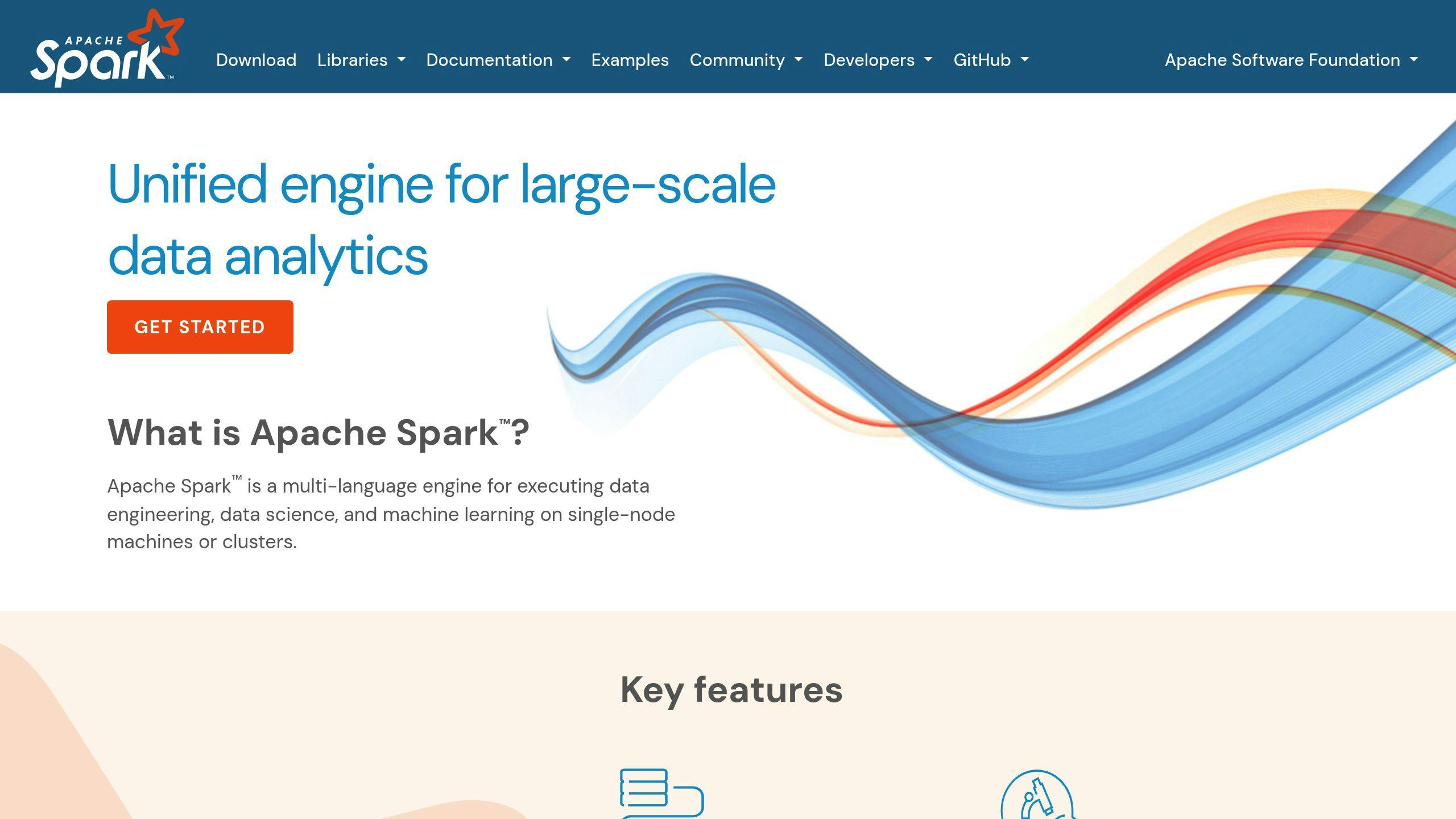
Apache Spark processes big data up to 100 times faster than Hadoop MapReduce, thanks to its in-memory processing capabilities [1]. This speed is a game-changer for marketers who need real-time insights from massive customer datasets.
One standout feature is Spark Streaming, which allows marketers to analyze customer behavior as it happens. This means campaigns can be adjusted instantly, making it a go-to tool for companies like Netflix and eBay. These businesses use Spark to deliver personalized recommendations and fine-tune user experiences on the fly.
Matei Zaharia, the creator of Apache Spark, underscores its impact:
"Apache Spark has become a critical tool for real-time data processing and analytics, enabling businesses to make data-driven decisions." [2]
For marketing teams, Spark's MLlib (Machine Learning Library) adds predictive analytics to the mix, offering tools to:
- Predict customer churn or purchase likelihood to sharpen marketing strategies.
- Optimize campaigns in real time, ensuring better outcomes.
These capabilities allow marketers to act quickly on data, improving campaign effectiveness and boosting ROI.
What sets Spark apart is its ability to handle various types of data processing:
| Processing Type | Marketing Application | Benefit |
|---|---|---|
| Batch Processing | Historical campaign analysis | Insights from past performance |
| Stream Processing | Real-time customer behavior | Immediate adjustments |
| Interactive Analysis | Ad-hoc segmentation | Flexible data exploration |
Additionally, Spark SQL integrates seamlessly with tools like Tableau and Power BI, as well as existing databases. While Spark is free and open-source, it does require robust infrastructure and skilled personnel to set up and maintain. Its scalability makes it a fit for both startups and enterprises, as it can handle increasing data loads with ease.
Although Spark excels at real-time and predictive analytics, tools like Tableau complement it by turning these insights into actionable visualizations for marketing teams.
3. Tableau

Tableau works seamlessly with platforms like Hadoop and Spark, making it a go-to tool for visualizing complex marketing data. It turns raw data into actionable insights almost instantly.
Take Nike, for example. They use Tableau to analyze customer behavior across their digital platforms, pulling data from over 50 sources. This allows them to create detailed visualizations of the customer journey, which helps shape marketing strategies that deliver measurable results.
Here’s how Tableau helps marketers tackle complex data:
| Feature | Marketing Application | Business Impact |
|---|---|---|
| Live Data Connections | Real-time campaign monitoring | Faster ad spend optimization |
| Interactive Dashboards | Cross-channel performance tracking | A clear, unified view of marketing data |
| Predictive Analytics | Customer behavior forecasting | Smarter, proactive campaign adjustments |
For enterprise teams, Tableau's ability to handle diverse data sources is a game-changer. Walmart, for instance, analyzes over 1 million customer transactions daily using Tableau. This helps them tweak promotional strategies in real time based on buying trends.
"Our retail clients have seen an average 20% improvement in marketing ROI by using Tableau's real-time analytics to optimize their campaign performance and customer targeting strategies."
Tableau’s pricing starts at $35 per user per month for the Creator plan, which offers full analytics capabilities. This makes it a solid choice for mid-sized teams while also scaling to meet enterprise needs. Its drag-and-drop interface makes data analysis accessible for non-technical users, while advanced features cater to experienced analysts.
That said, while Tableau is excellent for visualization, tools like Microsoft Power BI provide additional analytics options for enterprise-level needs.
4. Microsoft Power BI

Microsoft Power BI is a powerful analytics tool designed for marketing teams working with large datasets. It combines advanced analytics with smooth integration into Microsoft's ecosystem, making it a go-to option for teams needing both data visualization and enterprise-level insights.
According to Forrester, Power BI delivers an impressive 361% ROI over three years. This is largely due to its ability to handle data from multiple marketing channels at once, providing real-time insights that help teams make informed decisions quickly.
Here’s a look at some of its standout features and their marketing applications:
| Feature | Marketing Application |
|---|---|
| Real-time Streaming | Monitor live campaigns and adjust performance on the fly |
| AI-powered Analytics | Analyze customer behavior to fine-tune campaigns |
| Cross-platform Integration | Combine data from multiple channels for unified analysis |
| Custom Dashboards | Simplify ROI tracking and performance reporting |
At just $10 per user per month for the Pro version, Power BI offers high-level analytics at a budget-friendly price. Plus, its integration with Microsoft tools like Office 365 makes it easier for teams already using those products to get started without a steep learning curve.
"Power BI users have seen significant improvements in data analysis speed and decision-making accuracy, with the AI-powered insights becoming a game-changer for marketing strategy optimization", says Microsoft's analytics team.
Coca-Cola is a great example of Power BI in action. By integrating data from their CRM, social media, and transactional systems, they increased campaign engagement by 23%.
The platform also uses machine learning to spot trends and anomalies, helping marketers act on opportunities faster. And with its integration into Azure services, it offers even greater capabilities for processing and visualizing complex datasets without sacrificing performance.
While Power BI shines in handling large-scale analytics and integrations, Google BigQuery remains the better choice for businesses that prioritize scalability for massive datasets.
5. Google BigQuery

Google BigQuery is a powerful tool for handling large-scale marketing datasets without the hassle of setting up complex infrastructure. This fully-managed data warehouse processes up to 100,000 rows per second for real-time updates [1], making it a great fit for live marketing analytics and campaign adjustments.
Storage costs are simple: $0.02 per GB per month for active data and $0.01 per GB per month for long-term storage [2]. This pricing model allows marketers to quickly analyze data and make decisions that can improve campaign performance and return on investment.
BigQuery makes it easy to monitor campaigns in real time, build predictive models, and combine data from platforms like Google Analytics, Google Ads, and CRM systems. You can even create custom dashboards using Data Studio, thanks to its smooth integration with the Google Marketing Platform.
Its columnar storage format speeds up queries compared to traditional systems, which is especially useful for analyzing multi-channel campaigns or long-term customer trends.
One standout feature is its built-in machine learning tools. These allow marketers to forecast metrics like customer churn, purchase behavior, and campaign performance directly within BigQuery - no additional software required.
BigQuery also scales automatically, maintaining performance during busy marketing periods or when processing large volumes of historical data. For those looking to simplify data collection from various platforms, tools like Supermetrics work well alongside BigQuery’s advanced analytics capabilities.
sbb-itb-5174ba0
6. Supermetrics
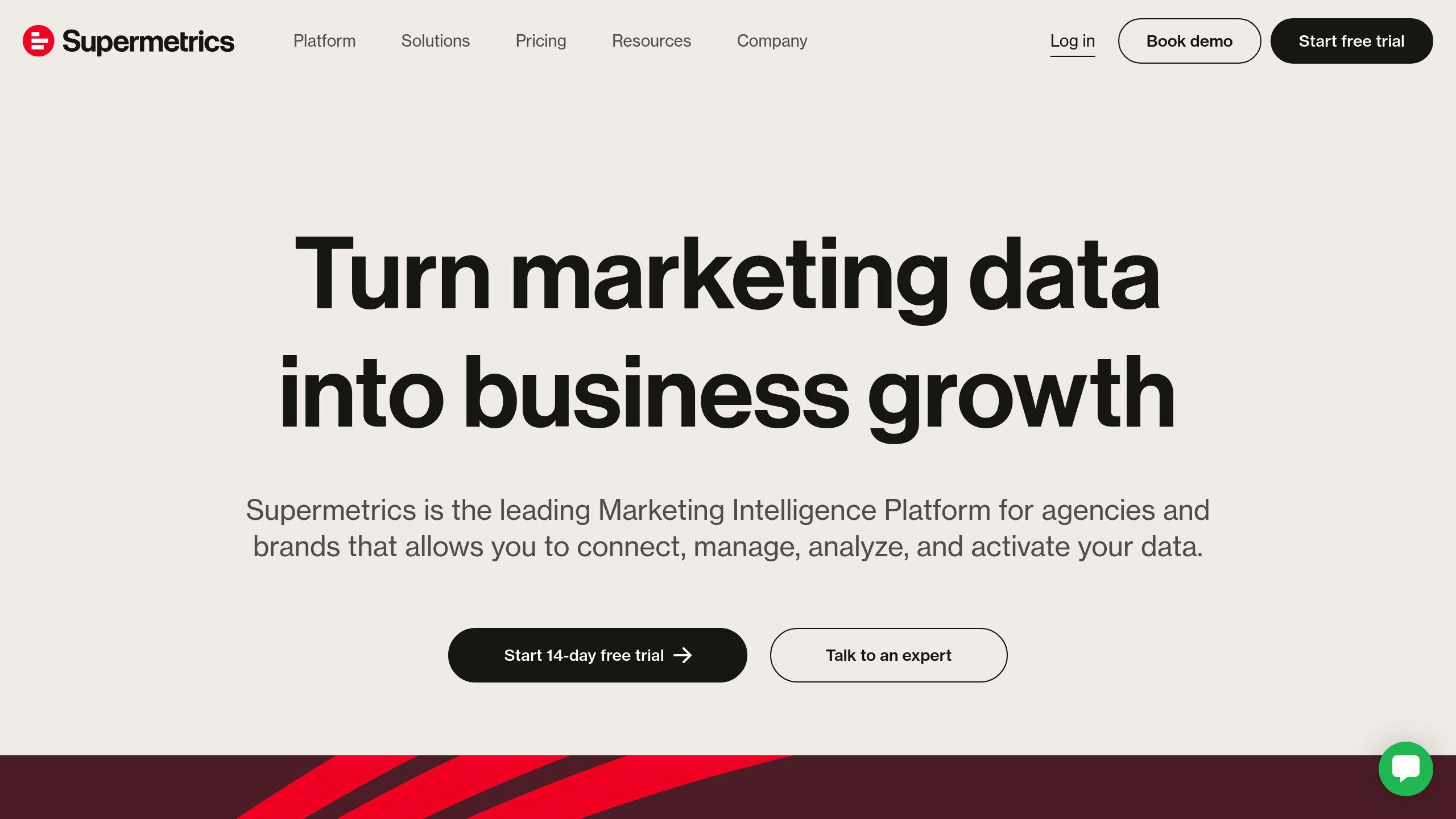
Supermetrics is a tool designed to simplify data integration, making it easier for marketers to focus on strategy instead of spending time managing data. It handles large datasets from more than 60 marketing platforms, helping teams save time and reduce errors.
One of its standout features is real-time analytics, which lets marketers track campaign performance as it happens. This means you can make quick changes to large campaigns across different channels without delay. The platform continuously updates data from connected sources, providing up-to-the-minute performance metrics for immediate adjustments.
Supermetrics is particularly strong in multi-channel reporting. It brings together data from over 60 platforms, including popular tools like Google Analytics, Facebook Ads, and HubSpot. It also integrates seamlessly with data visualization tools like Google Data Studio, automating data collection and reporting processes.
The platform’s dashboards simplify complex datasets, turning them into actionable information. Automated reporting ensures you always have the latest insights, while real-time data updates cut down on manual work.
For businesses concerned about data security, Supermetrics uses strong encryption and complies with major data protection laws like GDPR and CCPA. This makes it a reliable choice for companies handling sensitive information.
Pricing starts at $39 per month for the Core plan, with costs increasing based on data volume and the number of integrations. By automating data processes, Supermetrics helps businesses speed up reporting and analysis, which is especially useful for teams needing to make quick, data-driven decisions.
While Supermetrics focuses on simplifying data integration and reporting, tools like Adverity offer more advanced options for in-depth data transformation and analysis.
7. Adverity
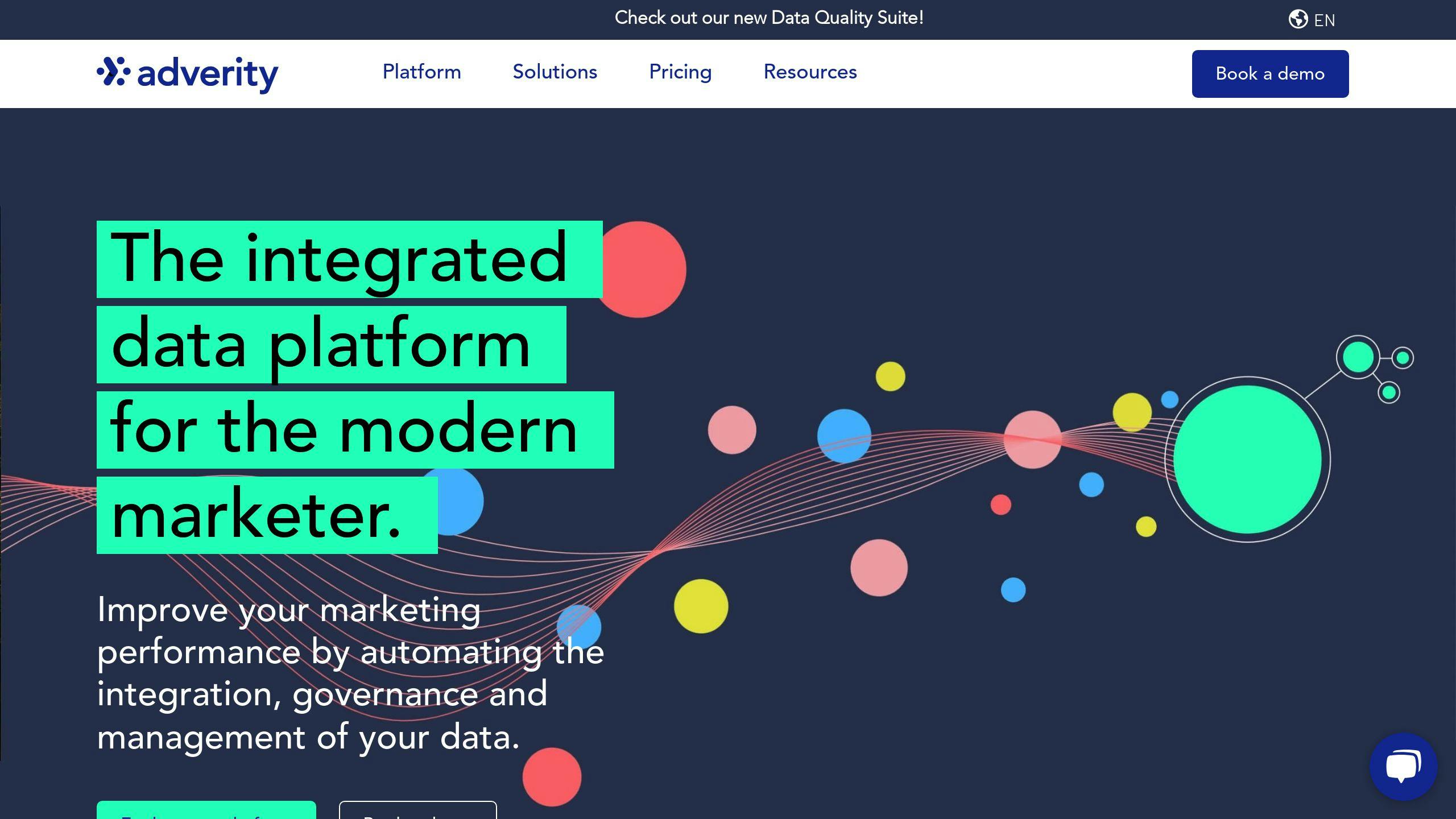
Adverity is a data integration and analytics platform designed to handle large-scale marketing data. With its AI-powered processing engine, it helps marketers manage extensive datasets efficiently without slowing down.
One of Adverity's standout features is its ability to pull data from multiple sources simultaneously using pre-built integrations. It connects seamlessly with tools like Google Analytics, Facebook Ads, and Salesforce, creating a centralized hub for marketing data.
The platform continuously processes data, delivering real-time insights that help marketers make quicker, data-driven decisions. It’s built to handle vast amounts of data, ensuring smooth performance even at scale.
Adverity also shines in data visualization. Its customizable dashboards turn complex datasets into clear, visual reports, making it easier for teams to share insights. Additionally, the platform prioritizes data security and complies with regulations like GDPR and CCPA.
"By leveraging Adverity's real-time analytics and data visualization capabilities, a leading e-commerce company was able to optimize its marketing campaigns and achieve a 25% increase in sales through unified customer behavior analysis."
Adverity has earned a 4.5-star rating on Gartner and offers a free demo, with pricing tailored to individual client needs.
For businesses juggling multiple data sources and advanced analytics, Adverity combines powerful features with ease of use. Its AI-driven data processing and visualization tools make it a strong choice for marketing teams. However, if you're looking for a simpler solution for automating multi-channel data workflows, Funnel.io might be worth exploring.
8. Funnel.io
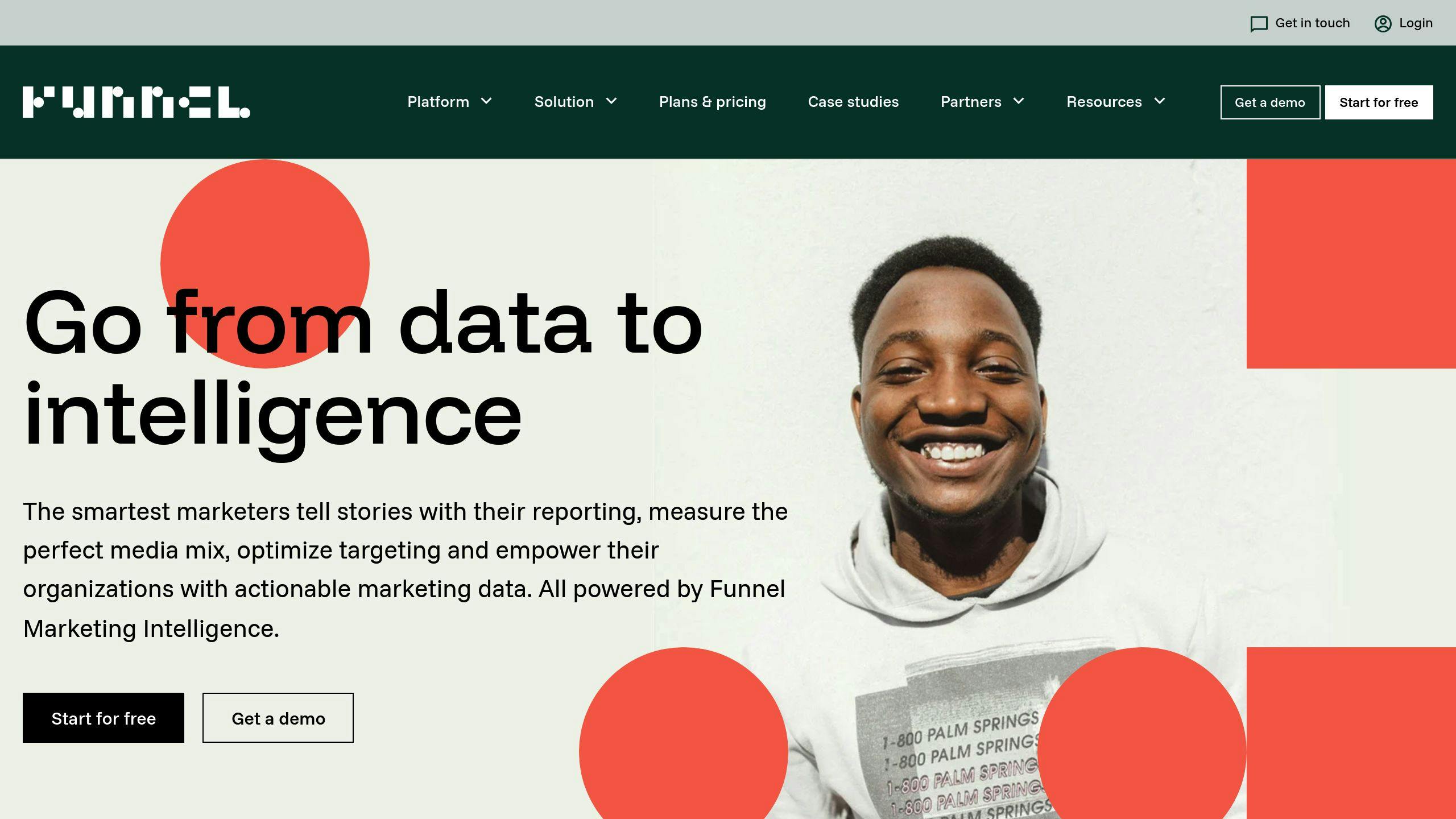
Funnel.io is a data integration and analytics platform built for marketers working with large datasets. It’s designed to simplify the process of managing and analyzing data from multiple sources.
The platform offers over 500 pre-built connections, making it easy to integrate data from various channels - even for teams without technical expertise. Its interface is straightforward and efficient, allowing users to handle vast amounts of information without hassle.
Funnel.io also provides tools to turn raw data into clear visuals. With customizable charts and graphs, marketers can quickly identify trends and insights. The real-time analytics dashboard gives instant updates on campaign performance and customer behavior, making it easier to monitor key metrics across different channels.
Users on Gartner Peer Insights rate Funnel.io highly, with an average of 4.5/5 based on 137 reviews. Many highlight the platform’s wide range of integrations and dependable customer support.
To make the most of Funnel.io, businesses should connect all relevant data sources, create dashboards tailored to their goals, and regularly review performance metrics. The platform’s ability to unify data from multiple platforms helps marketers tackle the challenges of big data.
Funnel.io offers custom pricing based on business needs but includes a free trial for testing its features. For companies juggling multiple marketing channels and large datasets, it provides a strong mix of data-handling power and ease of use.
While Funnel.io excels at integrating and visualizing data, SEMrush remains a top choice for businesses focused specifically on search marketing analytics.
9. SEMrush
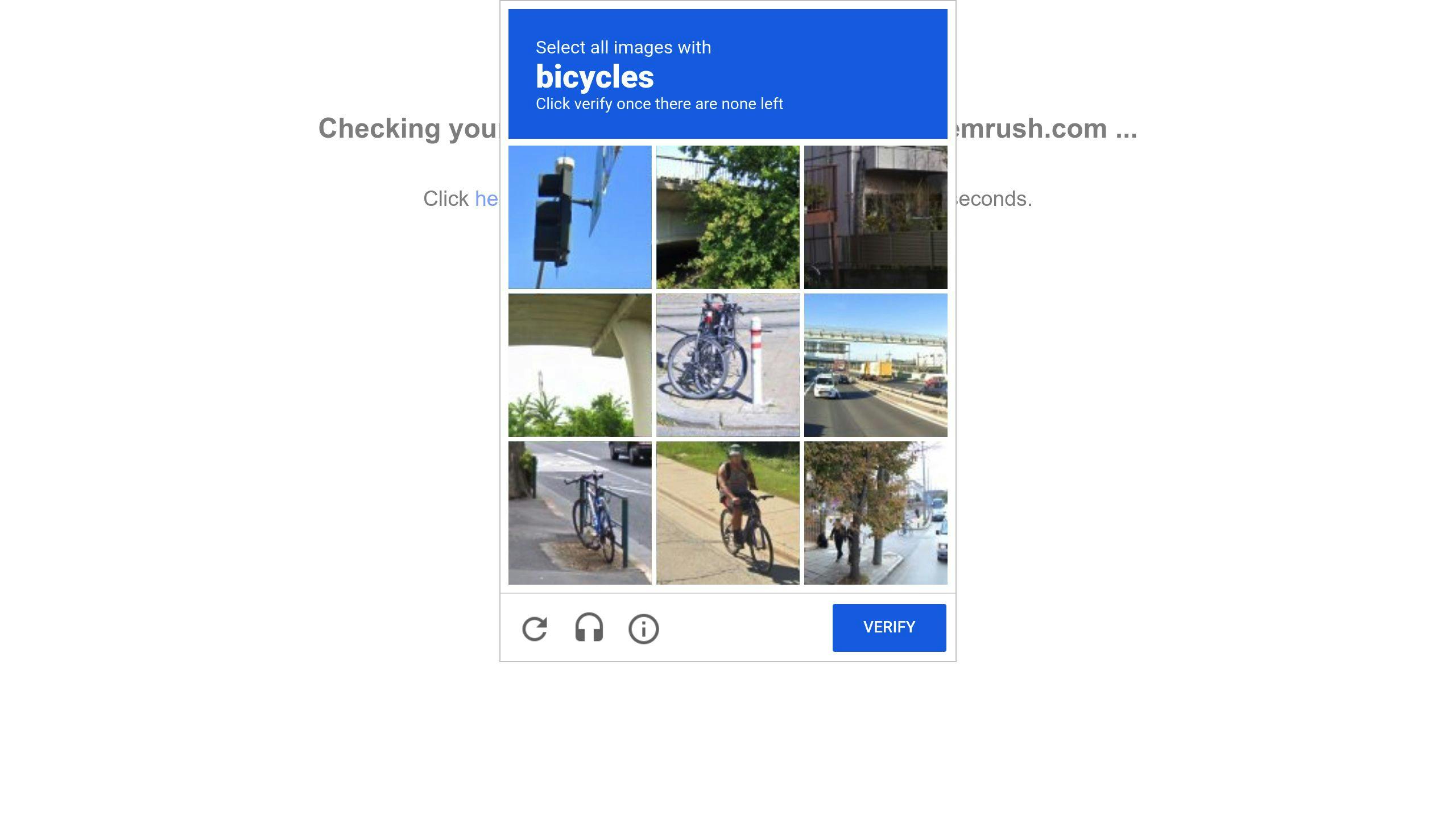
SEMrush is a big data analytics platform designed to support digital marketing strategies. It processes large datasets to provide insights that help marketers make informed decisions.
With real-time analytics, SEMrush offers instant insights across multiple channels. Features like Position Tracking allow users to monitor daily SEO performance and adjust their strategies as needed. The platform also analyzes search volumes, competition levels, and cost-per-click trends using advanced algorithms.
SEMrush works seamlessly with tools like Google Analytics, Google Ads, and various social platforms. This integration creates a unified dashboard where users can track traffic, conversions, and ad performance. The My Reports feature simplifies complex data by merging information from different sources into easy-to-understand reports.
Pricing starts at $119.95/month for small businesses and goes up to $449.95/month for enterprises with larger data requirements.
Using machine learning, SEMrush identifies patterns in big data and provides actionable recommendations. For example, one e-commerce company improved its SEO strategy with SEMrush, leading to a 25% boost in organic traffic through targeted keyword optimization and technical SEO updates.
Additionally, SEMrush integrates with the Marketing Analytics Tools Directory, making it easier for businesses to compare and evaluate analytics tools. This helps companies find solutions that align with their specific goals and needs.
10. Marketing Analytics Tools Directory
Navigating the world of big data marketing can feel overwhelming, especially with so many tools to choose from. The Marketing Analytics Tools Directory simplifies this process by offering a platform to discover and compare marketing tools, complete with organized categories and detailed evaluations.
This directory lets you filter tools based on essential features like real-time analytics, integration capabilities, and scalability. Whether you're looking for tools that handle real-time data, integrate smoothly with other platforms, or scale alongside your business, this resource makes it easier to find what you need.
One standout feature is its side-by-side comparison system, which includes key details such as:
| Comparison Criteria | Information Included |
|---|---|
| Processing Capabilities | Handles data volume, speed, and scalability |
| Usability & Customization | Integration options, dashboards, reporting |
| Pricing Structure | Plan details, enterprise options, costs |
The directory is especially useful for businesses with specific big data marketing needs. For instance, if you need real-time analytics, you can filter for tools that connect with platforms like Google Analytics or social media. If advanced data processing is a priority, you can focus on solutions compatible with Apache Hadoop or Spark.
Each tool listing includes specifications, user reviews, and integration information, making comparisons straightforward. DevriX ensures the directory stays up-to-date, helping businesses refine their big data marketing strategies effectively.
Comparison Table
Here's a detailed look at some of the top big data marketing tools, broken down by essential features:
| Tool | Scalability | Integration Capabilities | Visualization Features | Best For | Starting Price |
|---|---|---|---|---|---|
| Apache Hadoop | Handles large-scale distributed processing | Requires custom integration development | Basic visualization tools | Processing massive datasets | Free (Open-source) |
| Apache Spark | Excels with real-time processing needs | Supports multiple APIs and programming languages | Limited built-in visualizations | Real-time analytics | Free (Open-source) |
| Tableau | Scales from small to large teams | 75+ native data connectors | Advanced interactive dashboards and charts | Data visualization | $35/user/month |
| Microsoft Power BI | Scales to enterprise-level needs | Integrates with 120+ data sources, optimized for Microsoft tools | Extensive visualization library with custom reporting | Business intelligence | $9.99/user/month |
| Google BigQuery | Cloud-based scalability without limits | Seamless Google Cloud integration | Basic visuals via Data Studio | Data warehousing | Usage-based pricing |
| Supermetrics | Suitable for small to medium-sized setups | Connects with 70+ marketing platforms | Pre-designed reporting templates | Aggregating marketing data | $39/month |
| Adverity | Designed for high-volume scalability | Integrates with 600+ data sources | Custom dashboards and automated reports | Marketing intelligence | Custom pricing |
| Funnel.io | Adapts to medium and large-scale needs | Links to 500+ marketing platforms | Offers customizable dashboards | Automating marketing data | $499/month |
| SEMrush | Works well for mid-sized projects | Focused on marketing platform data | Standard marketing visualizations | SEO and marketing analytics | $119.95/month |
Key Takeaways:
- Adverity and Funnel.io are top choices for integration-heavy needs.
- Tableau and Power BI shine in creating detailed, interactive visualizations.
- Open-source tools like Hadoop and Spark are ideal for teams with advanced technical skills.
- Cloud-based options like Google BigQuery offer flexible scaling for dynamic workloads.
Note: Pricing and features are accurate as of January 2025 and may vary depending on specific plans.
Understanding these tools can help marketers effectively use big data to refine strategies and maximize ROI. Up next, we’ll dive into how these platforms contribute to marketing success.
Conclusion
As data-driven marketing continues to expand, choosing the right tools has become essential for staying ahead. The platforms mentioned in this article offer practical solutions for turning big data into actionable marketing insights.
Many businesses still face challenges in managing and analyzing their data. That’s where resources like the Marketing Analytics Tools Directory come in handy. It provides side-by-side comparisons and in-depth reviews to help organizations identify tools that fit their specific marketing goals.
From user-friendly options like Tableau to more advanced platforms like Apache Spark, the right tools can help transform overwhelming data into clear insights. Tools like Google BigQuery and Adverity show how integrating real-time analytics can elevate your marketing strategy.
Success in big data marketing isn’t just about the tools - it’s about using them effectively within a well-thought-out strategy. Take the time to assess your needs, experiment with solutions, and gradually develop your analytics framework. Investing in the right tools and expertise today can lead to smarter campaigns, stronger customer connections, and better returns on your marketing efforts.


